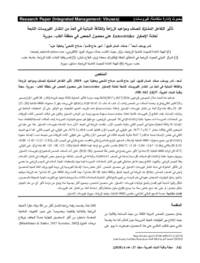Effect of interaction among variety, planting date and plant density on incidence of luteoviruses naturally infecting chickpea in Al Ghab region of Syria

Authors:
Luteoviruses (family Luteoviridae), persistently transmitted by aphids are among the most important viruses which cause economical losses and show yellowing and stunting symptoms on legume crops worldwide, including Syria. Field experiments were carried out at Al Ghab Scientific Agricultural Research Center, Hama, Syria, during the 2016/2017 and 2017/2018 cropping seasons to study the interaction of planting dates (10 December, 30 December and 20 January), chickpea cultivars (Ghab 3, Ghab 4, Ghab 5, FLIP95-67 and JG62) and plant densities (20, 25, 30, 35 and 40 plant/m2 ) on chickpea infection with luteoviruses under natural infection conditions. Tissue blot-immunoassay (TBIA) results showed that luteoviruses were the main cause of stunting and yellowing symptoms on randomly selected chickpea plants. Differences observed were highly significant (P < 0.001) in the two cropping seasons. However, all recorded parameters (infected plant no./plot, virus incidence (%) and grain yield) during 2016/2017 were significantly higher than that of 2017/2018. The early planting date (10 December) reduced virus incidence by 55.7 and 77.7% in 2016/2017, and 48.9 and 73.3% in 2017/2018, compared to other planting dates (30 December and 20 January, respectively). In addition, incidence of luteoviruses were reduced by 49.6 and 47.7% on the second planting date compared to third planting date in 2016/2017 and 2017/2018 growing seasons, respectively. Disease incidence differed significantly (P< 0.001) at all plant densities levels (with the exception of that between 4th and 5th levels) and decreased gradually (2.93>2.12>1.45>0.90>0.55%) and (3.46> 2.67> 1.94> 1.19> 0.71%) in 2016/2017 and 2017/2018, respectively, contrary to increased plant density levels (20< 25< 30< 35< 40 plant/m2, respectively). However, grain yield was decreased by 20-28% when plant density was more than 35 plant/m2 . Chickpea varieties reacted differently (P< 0.001) and showed variable levels of disease incidence; the lowest and highest infections (%) were recorded on FLIP95- 67 and JG62 genotypes, respectively. Disease incidence was reduced, and grain yield was enhanced considerably (even for JG62, the susceptible variety) when planting early (up to mid-December) with plant density of 20-30 plant/m2 and when proper variety (such as Ghab4 or FLIP95-67) were used. On the other hand, increasing plant density up to 35 plant/m2 was suitable for the late sowing date. It is worth mentioning that the results of this study which evaluated the role of interaction between three treatments may provide the basics for better understanding of luteoviruses epidemiology in chickpeas. The study provided sustainable practical options for the control of such viruses.
